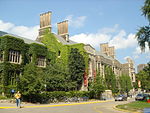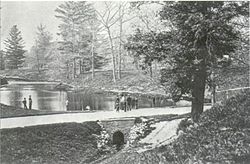Back Campus Fields
2014 establishments in OntarioField hockey venues in CanadaPublic–private partnership projects in CanadaSoccer venues in CanadaSports venues completed in 2014 ... and 5 more
Sports venues in TorontoUniversity of Toronto buildingsUniversity sports venues in CanadaVenues of the 2015 Pan American GamesVenues of the 2015 Parapan American Games

The Back Campus Fields is a field hockey facility on the St. George Campus of the University of Toronto in Toronto, Ontario, Canada. The facility is the home to the school's Toronto Varsity Blues field hockey team. The facility was built for the 2015 Pan American Games and hosted the field hockey competition for the games. The facility also hosted 5 and 7-a-side football competitions during the 2015 Parapan American Games. The facility was referred to as the Pan Am/Parapan Am Fields during the games.
Excerpt from the Wikipedia article Back Campus Fields (License: CC BY-SA 3.0, Authors, Images).Back Campus Fields
Helga and Mike Schmidt Performace Terrace, Toronto
Geographical coordinates (GPS) Address Website Nearby Places Show on map
Geographical coordinates (GPS)
| Latitude | Longitude |
|---|---|
| N 43.663861111111 ° | E -79.396333333333 ° |
Address
University of Toronto (University of Toronto - St. George Campus)
Helga and Mike Schmidt Performace Terrace
M5S 2E5 Toronto
Ontario, Canada
Open on Google Maps







